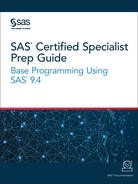Scenario 7
Code Solution
The solution listed
below is one example of a program that could be used to accomplish
each task within the scenario. Your code can be different, as long
as it results in the same answers.
data work.scenario7; /*#1*/ set cert.temp18; /*#2*/ format Day date9.; /*#3*/ Month=month(day); /*#4*/ run; proc freq data=work.scenario7; /*#5*/ tables HighTemp; /*#6*/ run; proc means data=work.scenario7; /*#7*/ class month; /*#8*/ var AvgLowTemp AvgHighTemp; /*#9*/ run;
| 1 | The DATA step creates a new temporary data set named Work.Scenario7. |
| 2 | The SET statement is used to read observations from one or more SAS data sets. |
| 3 | The FORMAT statement formats the Day variable in the date9. format. |
| 4 | The MONTH function returns the numeric value of the month within the Day variable. |
| 5 | The FREQ procedure creates one-way, two-way, and n-way tables. It also describes data by reporting the distribution of variable values. |
| 6 | The TABLES statement requests one-way to n-way frequency and crosstabulation tables and statistics. In this case, that is a one-way frequency with the default statistics for the variable HighTemp. |
| 7 | The MEANS procedure is used to compute descriptive statistics for the variables stated in the VAR statement. |
| 8 | The CLASS statement provides separate calculations for each value of the Month variable. |
| 9 | The VAR statement identifies the two variables, AvgLowTemp and AvgHighTemp, as the analysis variables, and also controls their order in the output. |
Output A2.9 PROC FREQ Results of High Temp

Output A2.10 PROC MEANS Results

Test Your Code Solution
-
Correct Answer: 2
-
Correct Answer: 64
-
Correct Answer: 29
-
Correct Answer: 3.17
Last updated: February 14, 2019
..................Content has been hidden....................
You can't read the all page of ebook, please click here login for view all page.
